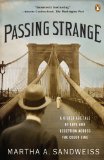Summary | Excerpt | Reading Guide | Reviews | Beyond the Book | Readalikes | Genres & Themes | Author Bio
A Gilded Age Tale of Love and Deception Across the Color Line

Critics' Opinion:
Readers' Opinion:
First Published:
Feb 2009, 384 pages
Paperback:
Jan 2010, 384 pages
 Book Reviewed by:
Book Reviewed by:
Megan Shaffer
Buy This Book
An Invented Life
Edward V. Brown, the census taker, moved slowly down North Prince Street, knocking on each and every door in this Flushing neighborhood of Queens, New York. It was June 5, 1900, a mild and sunny day in the first spring of a new century. And as federal census agents had done once a decade for more than a hundred years, he was counting Americans, compiling a mosaic portrait of the nation. Who lives here, he asked at each residence, and what is the occupants’ “color of skin,” their sex, their marital status, their age? For each of the inhabitants he recorded a birthplace, as well as the birthplaces of their parents, and for the foreign born he noted when they had emigrated and whether they were citizens of the United States. He wrote down everyone’s occupation, asked whether he or she could read and write, and separated the renters and boarders from the home owners. In his careful, neat hand, Brown dutifully recorded the data on the preprinted census sheets that would eventually find their way to Washington, D.C., and become part of the official twelfth census of the United States. Queens, that census would show, was much like the more densely settled community of Brooklyn, just to the west: it was overwhelmingly white, about 98 percent, with close to a quarter of those white residents foreign born.
As Brown made his way down North Prince Street, he encountered immigrants from Germany, England, Ireland, and Poland, families supported by men who worked as policemen, machinists, and clerks. At number 50, he met Mary Chase, a sixty- year- old widow from Rhode Island who ran a small boardinghouse, and took note of her black housekeeper, the widowed Deborah Peterson. He had counted seventy- two white residents on the street thus far, and Peterson, who descended from an African American family long resident in New York, was the first black person he had encountered. But then he walked next door and knocked at the large and comfortable home at 48 North Prince Street. Two black servants lived here. Phoebe Martin was a thirty-three-year-old widow, and Clarine Eldridge, just fourteen, was scarcely older than the children she had been hired to watch. It was afternoon, and Grace, age nine; Ada, age eight; and Sidney, age six, were home from school, perhaps playing with their three- year- old brother, Wallace. Whoever answered the door probably invited the census taker into the parlor; neither the servants nor the children could have answered his long list of personal questions about the family. And so Edward Brown entered the home to talk to Ada Todd, the lady of the house. Her husband, James, was away, she said, so she would answer the census agent’s long list of questions herself.
Brown hardly needed to ask her race. With a glance at her dark complexion and wavy black hair, he noted her “color of skin” as “black.” Mrs. Todd reported that her parents came from Georgia, and she told Brown that she could read and write. She said that she had been born in Georgia in December 1862. If Brown remembered his history, he might have wondered if Ada Todd had been born a slave. That question was not on his list, though, and he would not have asked.
Mrs. Todd then told Brown about her husband, James. She said that she had married him eighteen years earlier, in 1882. He was a black man, some twenty years her senior. Born in the West Indies, he had come to the United States in 1870, she said. Now a naturalized citizen, he had a job as a traveling steelworker. Perhaps Brown noted that the house seemed proof that Mr. Todd had done pretty well for himself, even if his work often kept him away from his home and his children. Mrs. Todd explained that there had been five: the four still at home and a fifth who had died as a toddler.
Edward Brown took pride in the accuracy of his records, in the neat way in which he filled in the 1,350 blank boxes on each of his census sheets, recording into being a portrait of the polyglot neighborhood springing up in the sparsely settled borough of Queens. And so, he would have been stunned to learn that almost nothing Mrs. Todd told him was true.
Excerpted from Passing Strange: A Gilded Age Tale of Love and Deception Across the Color Line by Martha A. Sandweiss. Reprinted by arrangement with The Penguin Press, a member of Penguin Group (USA), Inc. Copyright (c) February, 2009.





The Funeral Cryer by Wenyan Lu
Debut novelist Wenyan Lu brings us this witty yet profound story about one woman's midlife reawakening in contemporary rural China.
Your guide toexceptional books
BookBrowse seeks out and recommends the best in contemporary fiction and nonfiction—books that not only engage and entertain but also deepen our understanding of ourselves and the world around us.